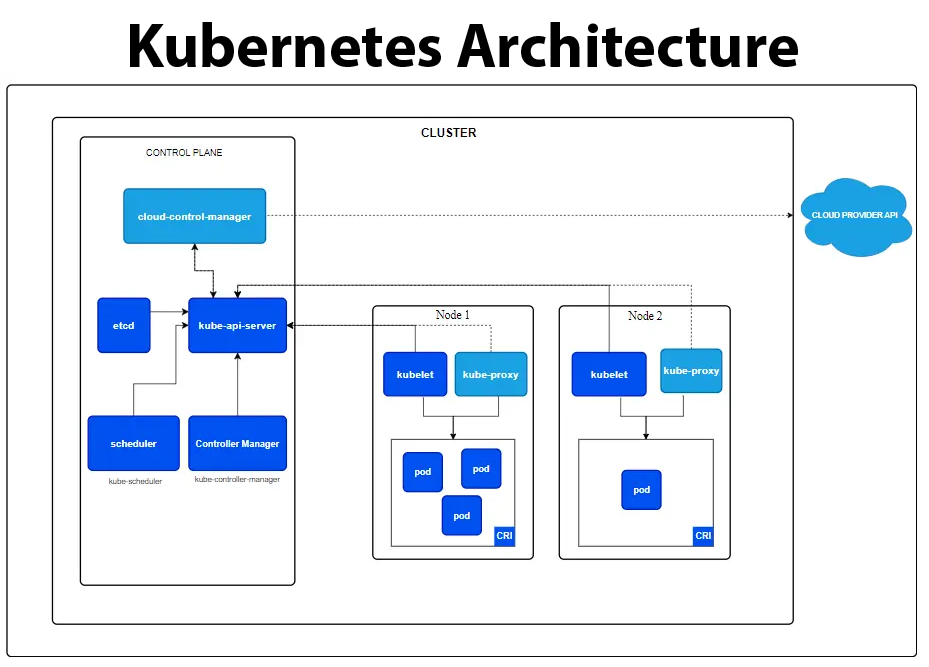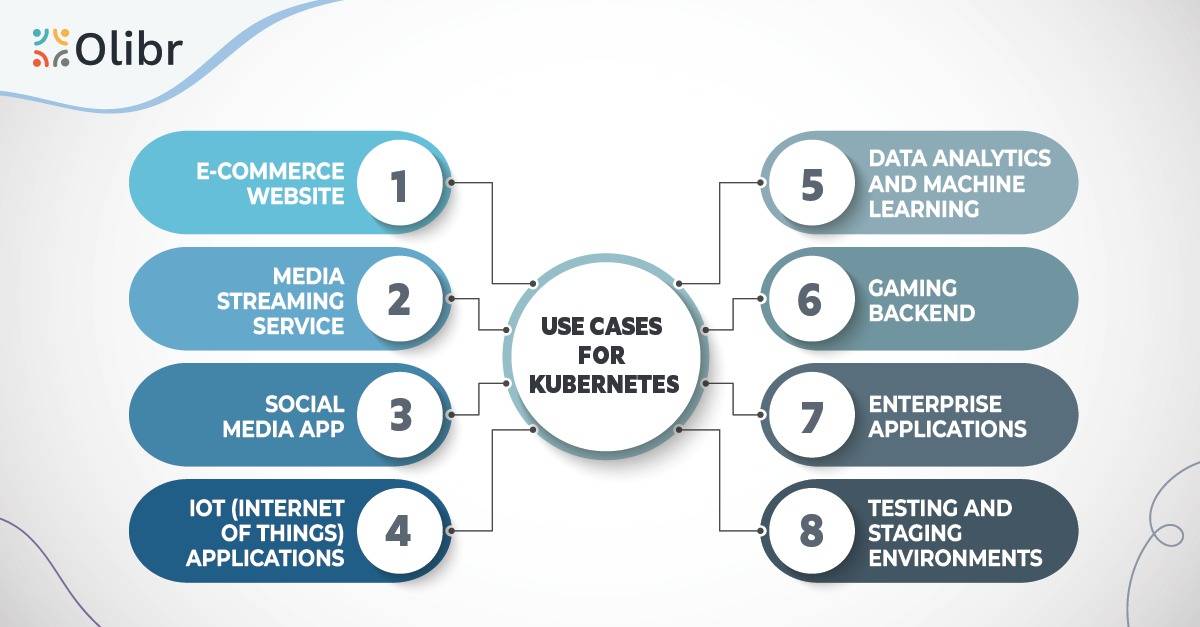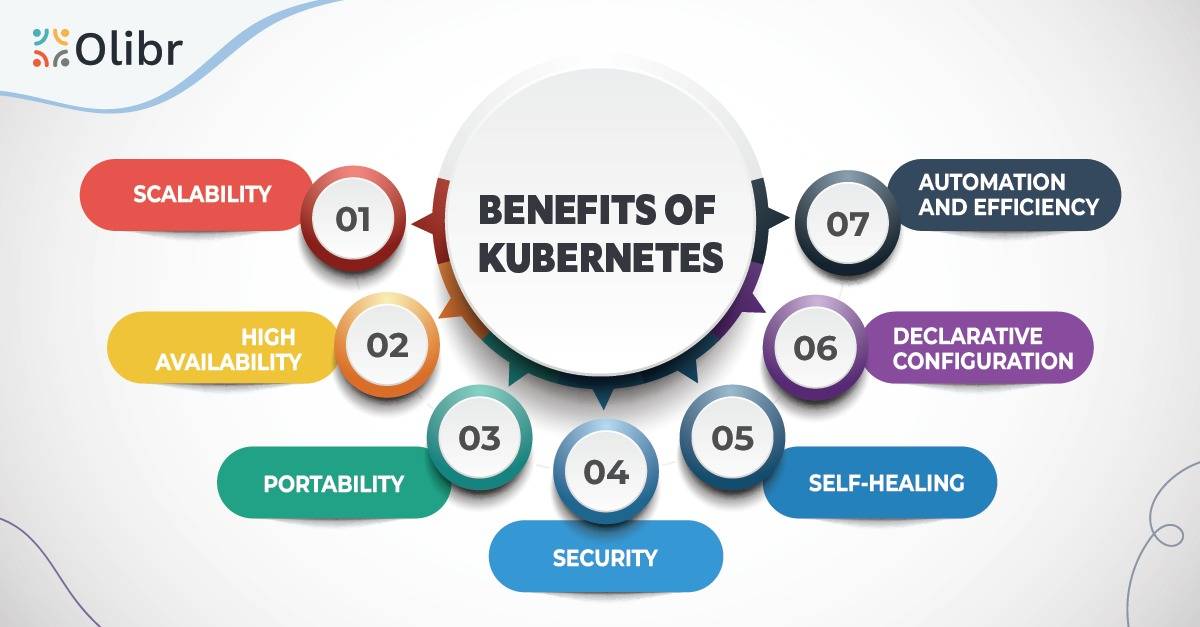Table of Contents
ToggleWhat is Kubernetes?
Containers capture applications, their dependencies, and configurations, thus providing a consistent environment for running software across different environments. Kubernetes, commonly abbreviated as K8s, is an open-source container orchestration platform developed by Google. It is designed to automate the deployment, scaling, and management of containerized applications. It was released in July 2015 and is written in Go language. The detailed Kubernetes documentation simplifies many concepts and offers built-in commands that help developers handle the heavy lifting of application management.
Kubernetes Architecture

Kubernetes has a client-server architecture where its components work together to manage the containerized workloads. The key components of Kubernetes architecture are:
Control Plane
It is the brain of Kubernetes architecture that manages and coordinates all activities. The control plane consists of the following components:
- API Server: The entry point for all administrative tasks and exposes the Kubernetes API.
- Scheduler: Assigns workloads or pods to nodes based on resource availability and constraints.
- Controller Manager: Watches the state of the Kubernetes cluster and ensures desired state is maintained (e.g., scaling, replication).
- etcd: A distributed key-value store that stores configuration data and cluster state.
Nodes
These are the worker machines of Kubernetes that run the containers. Each node is its own Linux environment. Nodes are the compute resources of the cluster. The components on nodes include:
- Kubelet: Ensures containers are running in a Pod.
- Container Runtime: Executes containers (e.g., Docker, containerd).
- Kube Proxy: Manages network rules for communication between Pods.
- Pods: Pod in Kubernetes is a basic deployable unit that holds one or more containers.
Container Runtime Engine
Nodes in Kubernetes architecture have container runtime engines that run the containers. A popular container runtime engine is Docker, but Kubernetes supports other runtimes like CRI-O and rkt, compliant with Open Container Initiative.
Kubelet service
Kublet is a small application that can communicate with the Kubernetes control plane. The kubelet ensures the smooth running of containers specified in pod configuration and manages their lifecycle. It is responsible for executing the actions commanded by the control plane.
Kube-proxy service
It is a network proxy that simplifies networking services in Kubernetes. It manages the network communications outside and inside the cluster, forwarding traffic or replying on the packet filtering layer of the operating system.

Don't miss out on your chance to work with the best
apply for top global job opportunities today!
Why do you need Kubernetes, and what can it do?
Managing containers and ensuring no downtime can be challenging in a production environment. That’s where Kubernetes comes into play. It’s a framework that helps run distributed systems without any issues. Moreover, Kubernetes handles scaling, failover, and deployment patterns. Further, it ensures that your application can be scaled horizontally by adding or removing Kubernetes pods based on demand. Additionally, Kubernetes makes sure that it can restart failed containers automatically or reschedule them to healthy nodes. Kubernetes can also detect pod fails and replace them with a new one. Kubernetes, thus, simplifies container management for businesses and streamlines deployment processes.
What Kubernetes is not?
- Firstly, Kubernetes is not a one-size-fits-all solution.
- Secondly, it’s not a traditional platform as a service (PaaS) system.
- Thirdly, it doesn’t tell you the types of applications or specific services you must use.
- Lastly, Kubernetes provides building blocks for developer platforms, thus, giving flexibility and choice to users.
What is Kubernetes used for?
The primary use cases of Kubernetes include:

- Container Orchestration: Kubernetes automates tasks such as container deployment, scaling, load balancing, and updates, making it easier to manage complex applications.
- Application Scaling: Kubernetes ensures that applications can handle varying levels of traffic and demand without manual intervention.
- Fault Tolerance and High Availability: Kubernetes ensures that applications remain available and operational even if some containers or nodes fail. Moreover, it automatically restarts failed containers and reschedules them on healthy nodes.
- Service Discovery and Load Balancing: Kubernetes allows applications to find and communicate with each other using DNS or environment variables. It also facilitates load balancing across containers within a service.
- Rolling Updates and Rollbacks: Kubernetes enables seamless updates of applications without downtime. It, thus, ensures that new versions are gradually rolled out while maintaining availability. In case of issues with the new version, it allows easy rollback to the previous stable version.
- Secrets and Configuration Management: Kubernetes allows the secure management of sensitive information, such as passwords, API keys, and certificates, through its secrets management feature. Moreover, it supports external configuration through ConfigMaps.
- Resource Management: Kubernetes allows users to define resource requirements (CPU, memory) and limits for containers. It, thus, ensures fair allocation of resources across the cluster.
- Multi-Cloud and Hybrid Cloud Deployments: Kubernetes can be deployed on various cloud providers or on-premises. Thus, it allows multi-cloud and hybrid cloud strategies.
Use Cases for Kubernetes

- E-commerce Website: If you run an online store and expect a surge in traffic during special events or sales, Kubernetes can automatically scale up your website to handle the increased number of visitors. This ensures your website remains fast and responsive during peak times.
- Media Streaming Service: For a media streaming platform, where users watch videos or listen to music, Kubernetes can dynamically adjust the number of servers running the streaming service based on the number of active users. Consequently, this helps optimize resources and ensures smooth playback for everyone.
- IoT (Internet of Things) Applications: For IoT projects that involve collecting data from numerous connected devices, Kubernetes can efficiently process and store the incoming data. Also, it can manage various microservices, and ensure the application runs smoothly across different locations.
- Data Analytics and Machine Learning: If you are working on data analysis or machine learning projects, Kubernetes can help you manage complex workflows involving data processing, model training, and serving predictions. That too, all in a scalable and resource-efficient manner.
- Gaming Backend: In the case of multiplayer online games, Kubernetes can handle the game servers’ deployment and scaling. Thus, ensuring a seamless gaming experience for players, even during peak gaming hours.
- Enterprise Applications: For large enterprises with multiple applications and services, Kubernetes can act as a unified platform for managing and orchestrating various components, making it easier to maintain, update, and scale the software.
- Testing and Staging Environments: In the DevOps workflow, Kubernetes acts as a tool that automates and streamlines application deployment and management. DevOps enhances software development and delivery processes by promoting collaboration between development and operations teams. Consequently, this allows developers to test changes and updates before deploying them to the live system.
Benefits of Kubernetes

- Scalability: Kubernetes provides automatic scaling and load balancing. This, thus, allows applications to scale up or down based on demand. It also ensures optimal resource utilization and cost efficiency.
- High Availability: Kubernetes ensures that applications are highly available by automatically handling container and node failures. Consequently, this reduces downtime and improves reliability.
- Portability: Kubernetes abstracts away the underlying infrastructure. It, thus, makes applications portable and easily deployable across different environments, whether on-premises, public clouds, or hybrid setups.
- Automation and Efficiency: Kubernetes automates many manual tasks related to deployment, scaling, and management. It, thus, reduces the operational overhead and streamlines the development and release processes.
- Declarative Configuration: Kubernetes uses a declarative approach to application configuration, defining desired states and automatically reconciling them, reducing the risk of configuration drift.
- Community and Ecosystem: Being open-source, Kubernetes has a vast and active community contributing to its development and expanding its ecosystem with various add-ons, plugins, and integrations.
- Self-Healing: Kubernetes continuously monitors the health of applications and automatically restarts or replaces failed containers, ensuring the overall health of the system.
- Security: Kubernetes provides built-in security features such as role-based access control (RBAC) and pod security policies, helping to secure containerized applications.
Take control of your career and land your dream job
sign up with us now and start applying for the best opportunities!

Final Thoughts
As organizations continue their multi-cloud journeys, Kubernetes remains a popular option due to its widespread availability as a cloud service offered by major providers. This availability simplifies cloud migration and makes Kubernetes an attractive choice for managing applications across different cloud environments. If you are a developer experienced in Kubernetes looking for opportunities that match your talent, sign up with Olibr now to learn more!
Frequently Asked Questions
No, Kubernetes is not Docker. Docker is a containerization platform that allows you to create and manage containers, while Kubernetes is a container orchestration platform that manages the deployment, scaling, and operation of containerized applications across a cluster of nodes.
Kubernetes is used in DevOps because it automates and streamlines the deployment, scaling, and management of containerized applications, making it easier for development and operations teams to work together and deliver software faster and more reliably.
Kubernetes is not a container or VM itself; it is a container orchestration platform that manages the deployment and operation of containers on VMs or physical machines.
Kubernetes is a container orchestration platform used to manage and deploy containerized applications, while DevOps is a set of practices and cultural principles that promote collaboration between development and operations teams to improve software development and delivery processes. In essence, Kubernetes is a tool used in the DevOps workflow to help automate and streamline the deployment and management of applications.
Namespaces in Kubernetes is a method to organize clusters into virtual sub-clusters. This feature helps when multiple teams or projects share a Kubernetes cluster.
Kubernetes service is a method for exposing a network application that is running as one or more Pods in your cluster. A service groups a set of Pod endpoints into a single resource.
Kubernetes deployment is a technique that tells Kubernetes how to create or modify instances of the pods that hold a containerized application. It simplifies managing application updates, ensures high availability, and allows seamless scaling.

